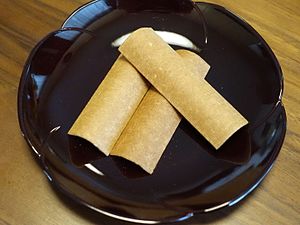 Yatsuhashi | |
| Type | Wagashi (miyagegashi) |
|---|---|
| Place of origin | Japan |
| Region or state | Kyoto |
| Main ingredients | Glutinous rice flour, sugar, cinnamon |
Yatsuhashi (八ツ橋 or 八橋) is a wagashi (Japanese confection) sold mainly as a souvenir snack (miyagegashi). It is one of the best known meibutsu (famous regional products) of Kyoto. It is made from glutinous rice flour (上新粉, jōshinko), sugar, and cinnamon. Baked, it is similar to senbei. The shape of the hard crackers resembles a Japanese harp or koto, or a bamboo stalk cut lengthways. Yatsuhashi was created in 1689 during the Genroku era (1688-1704) or in 1805 during the Bunka era (1804-1818) in the Edo period (1603-1868). The name Yatsuhashi comes from a scene in the Tale of Ise or from the musician Yatsuhashi Kengyo.[1] Yatsuhashi is a popular souvenir today, and according to a survey conducted by the city of Kyoto in 2022, 89.2% of Japanese tourists visiting Kyoto bought souvenirs, of which 10.7% bought Yatsuhashi.[2]
Raw, unbaked Nama yatsuhashi (生八ツ橋) has a soft, mochi-like texture and is often eaten wrapped around red bean paste (餡, an). The unbaked yatsuhashi (Nama yatsuhashi) is cut into a square shape after being rolled very thin, and folded in half diagonally to make a triangle shape, with the red bean paste inside. Unbaked yatsuhashi may also come in a variety of different flavours.[3] Popular flavours include cinnamon and matcha. Yatsutashi is also rolled into a rectangular shape and steamed. Nama yatsuhashi, created in 1960,[4] is a very popular souvenir of Kyoto. According to a survey conducted by the City of Kyoto in 2022, 89.2% of Japanese tourists who visited Kyoto bought souvenirs, of which 31.6% bought Nama yatsuhashi. This means that 42.3% of Japanese tourists who bought souvenirs in Kyoto in 2022 bought either Nama yatsuhashi or Yatsuhashi.[2]
References[edit]
- ^ "京のこだわり「伝統は法律より厳しい」八ツ橋創業年訴訟は続く". Sankei Business. 7 July 2020. Archived from the original on 1 November 2020. Retrieved 26 February 2024.
- ^ a b "観光客の動向等に係る調査" (PDF). Kyoto City. p. 45. Archived from the original (PDF) on 26 February 2024. Retrieved 26 February 2024.
- ^ "Yatsuhashi". This is Japan. 2017-05-09. Retrieved 2018-10-07.
- ^ "なぜ老舗同士がトラブル?~京菓子「八ツ橋」騒動". Yahoo News Japan. 6 June 2018. Archived from the original on 15 February 2024. Retrieved 26 February 2024.

